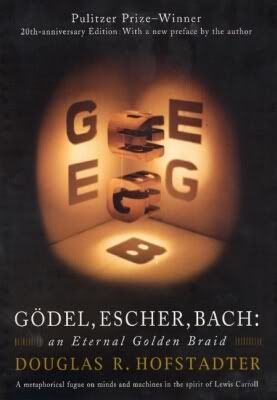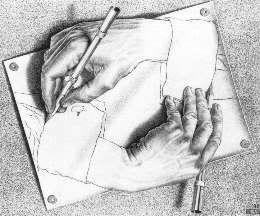
As the title gives away, it's a book that shows how connected (and even inseparable)concepts from the arts and sciences are. I actually believe the universe itself is a type of 'strange loop', but I'll save my thoughts on that for some other time. However, I do believe that many people feel a similar intuitive feeling about the universe without even having to know any of the science behind it. When people think of concepts like infinity for example, I think most come to some sort of understanding that some things must be circular for them to logically work out. It definitely makes your head spin to think about though. Just like a good shot of Jameson does. I suggest both at the same time.
So here's a couple of examples I always love to give because they are super simple but at the same time hard to wrap your mind around. The original form of this comes from an ancient Greek paradox (6 century BC!), known as the 'liar's paradox'.
Say this statement out loud and try to see whether you believe it is true or false.
"I am lying".
It may seem simple, but once you decide on it being true and take it as truth, you realize that you are admitting that you are actually lying. So then you decide it is false. But if it is false, then the statement would mean that you are telling the truth!! This will just sound like a bunch of words unless you really try it and think about it. It only takes a minute. DO IT!
Some might think this example doesn't make sense because it refers to itself (which is kind of the point), but to make it a little weirder and a little loopier here's a two parter fo' dat ass.
"The following statement is true. The preceding statement is false".
If you accept the first statement as being true and test it out, the second statement ends up making the first statement false. It continuously forces a flip flop in whatever decision you make concerning the validity of either sentence.
And what's crazy is that this isn't just some "trick", or play on words. When this logic was translated into mathematical and computational languages by Godel it literally turned the math world upside down, because it showed that math wasn't a language of absolute truth like we thought it was- that there would always be mathematical statements that could NEVER be proven, even in theory. When the full philosophical implications are understood (actually I'm not sure if anyone's realized them 'fully'), it drastically changes how one views reality.
Roger Penrose, one of the world's greatest mathematicians and physicists (who was awarded the nobel prize along with Stephen Hawking, (but isn't as famous cause he doesn't look like an alien or have a super cool robot voice), is one person who has written pretty extensively about this and similar concepts..
It was actually Penrose who described these sorts of concepts to M.C. Escher, who became super fascinated, and depicted them in what are now his most famous works. A rad example of how science inspires art. And then art in turn inspires thought on science.


No comments:
Post a Comment